Stack Frame and Passing Parameters
Stack Frames
Normally in a function we will have a local space for temporary variables within the function which are private to the rest of the program
These variables are never accessed outside the function and are destroyed after the function is complete
- If the function is recursive, this locality is to be confined to each call of the function as well
Conversely, variables also have scopes for which they can be global or local
- Global variables are created at compile time and are statically allocated
- Local variables are created at runtime and are dynamically allocated
We’ve covered static memory allocation, but how do we do dynamic allocation in ARM?
Usually, when a function is called, there is an activation record created alongside it, which includes the parameters, local variables, return address and a link to other records

- These records are also called stack frames
Handling in ARM
After we use each activation record, it must be deallocated, which is our responsibility in ARM (In CISC, this is taken care of for us)
Since we know about stacks already, we can use those to implement dynamic memory allocation
For each stack frame:
- We push it into the stack at the start of the subroutine and
- Pop it from the stack at the end of the subroutine
The best part about this is that we only need two pointers to do this: the stack pointer (SP) (r13) and the frame pointer (FP) (r11)
- In ARM, we need to maintain both the stack pointer and the frame pointer (this is handled for us in CISC)
For the frame pointer, we will always point at the base of the current stack frame and the stack pointer will always point to the top of the stack
Since the stack pointer can change during execution of the procedure, it’s best practice to access stack frame data from the frame pointer since it’s static throughout the procedure
For example, assume we have an FD stack and we want to store variable XYZ at 12 bytes below the frame pointer

If we add anything to the stack after this, we have to manually recalculate the location of XYZ which is a pain
What we can do instead is have a frame pointer sit at the base of the stack frame

Now when we want XYZ, we know exactly where it is no matter what happens to the stack
To create these stack frame, we must
- Push the old frame pointer onto the stack
- Make the frame pointer point to the bottom of the stack frame
In ARM, this looks something like this
- Move up the stack pointer by d bytes (d being the number of bytes we want to allocate for the routine)

-
Note that the highlighted instructions can be optimized with either of the following
STR fp, [sp,#-4]! STMFD sp!,{fp}
For the collapse, we do something like this

-
The highlighted instructions can also be combined with one of the following
LDR fp,[sp],#4 LDMFD sp!,{fp}
Visually, the process looks like this
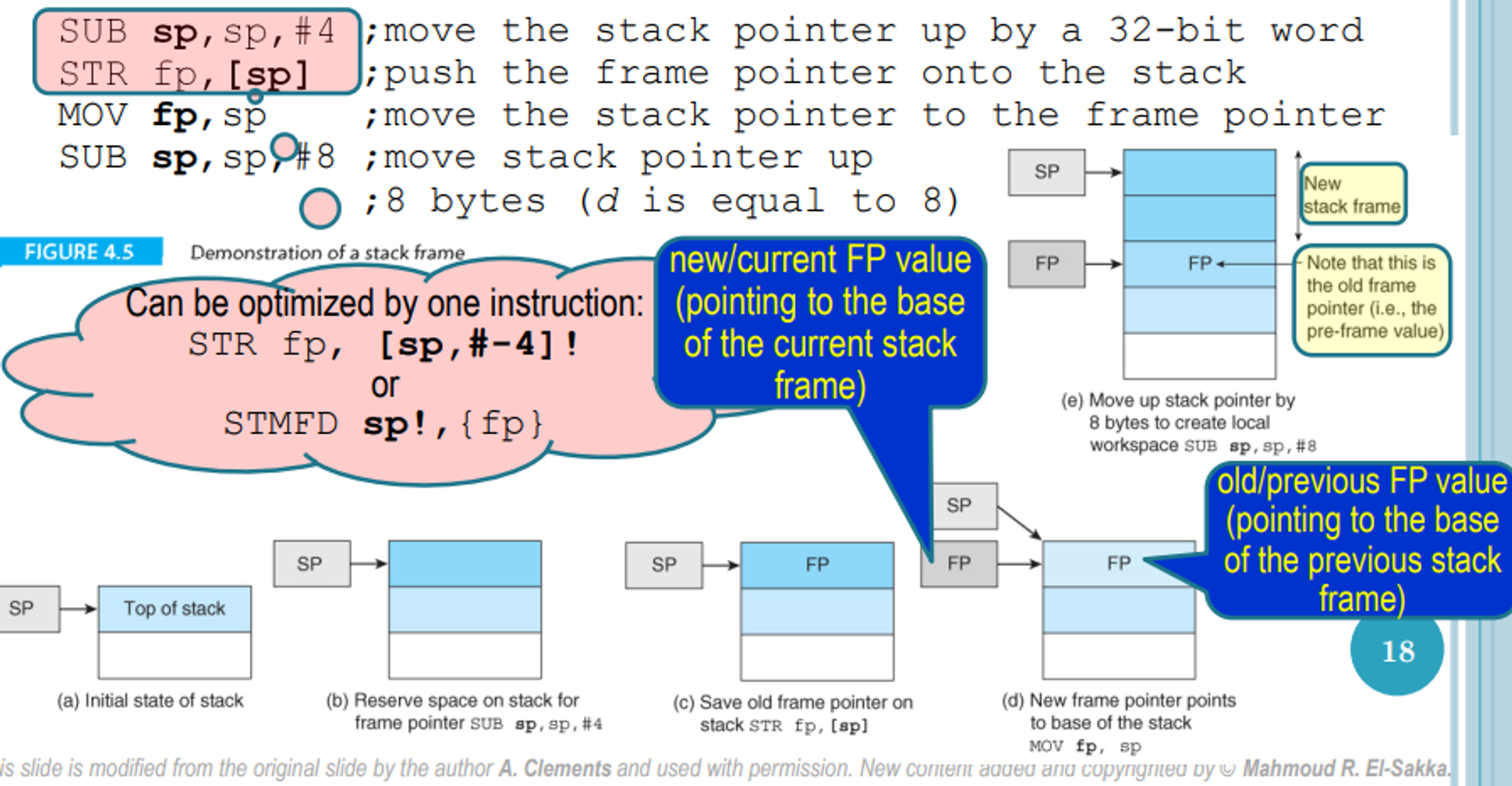
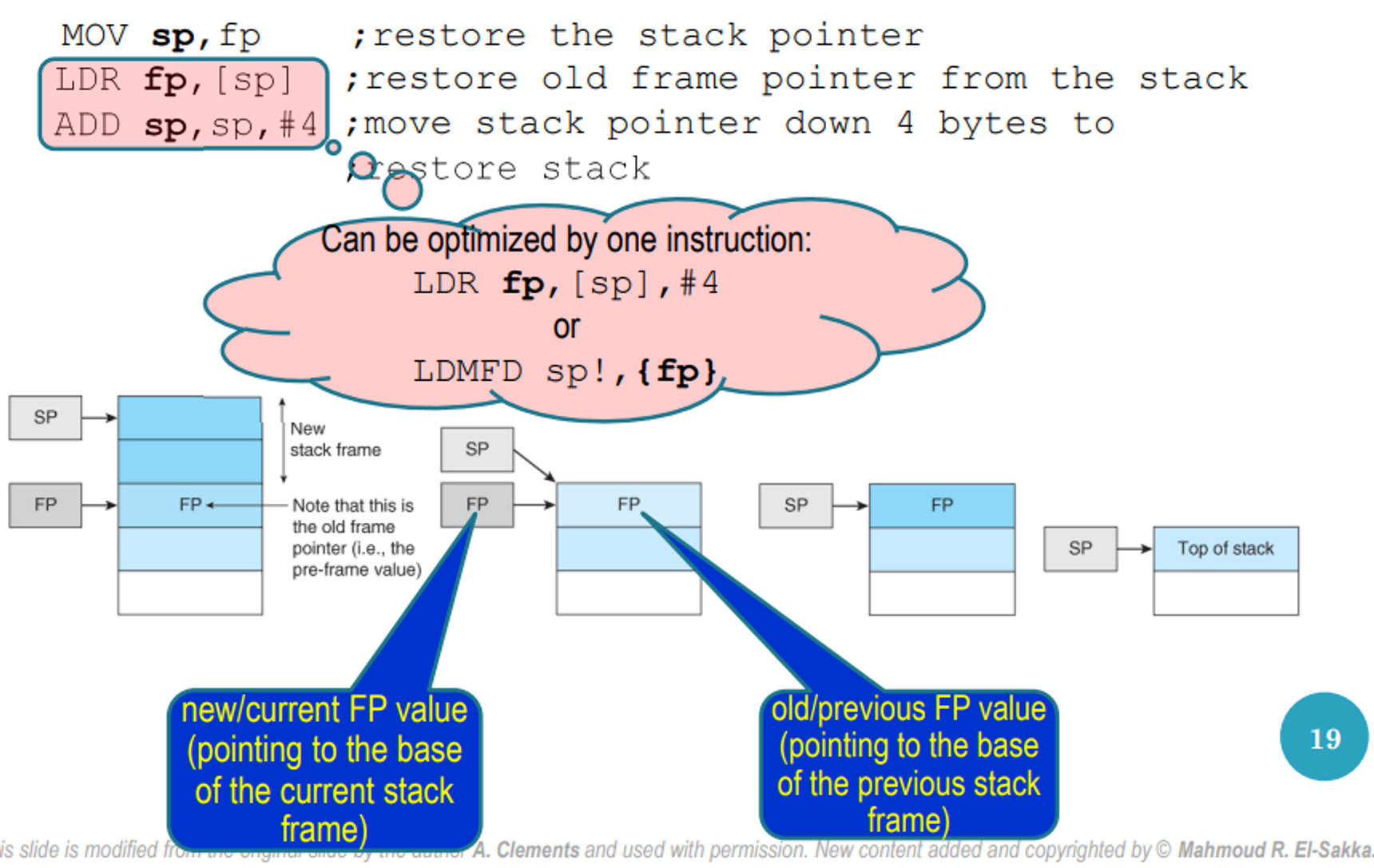
As a review, here’s the entire process of calling a subroutine
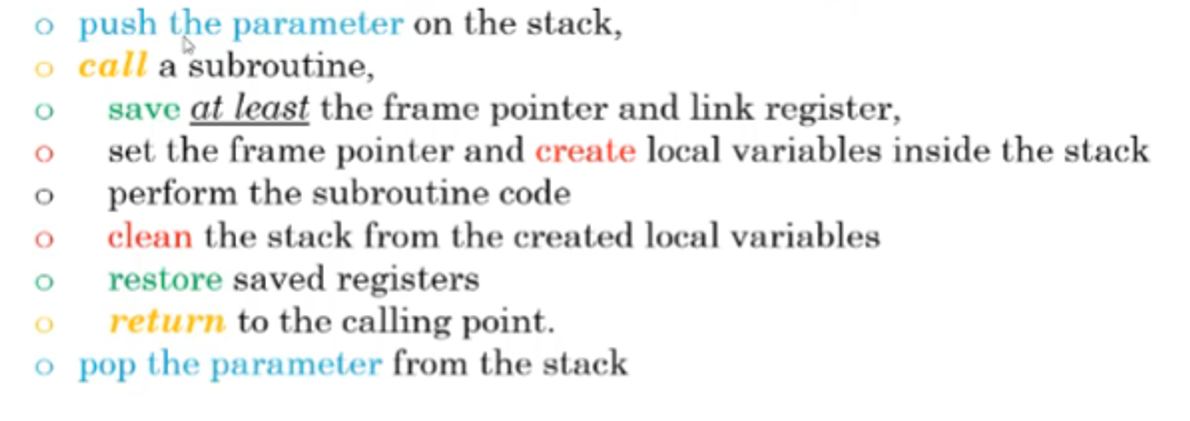
In ARM, it looks something like this

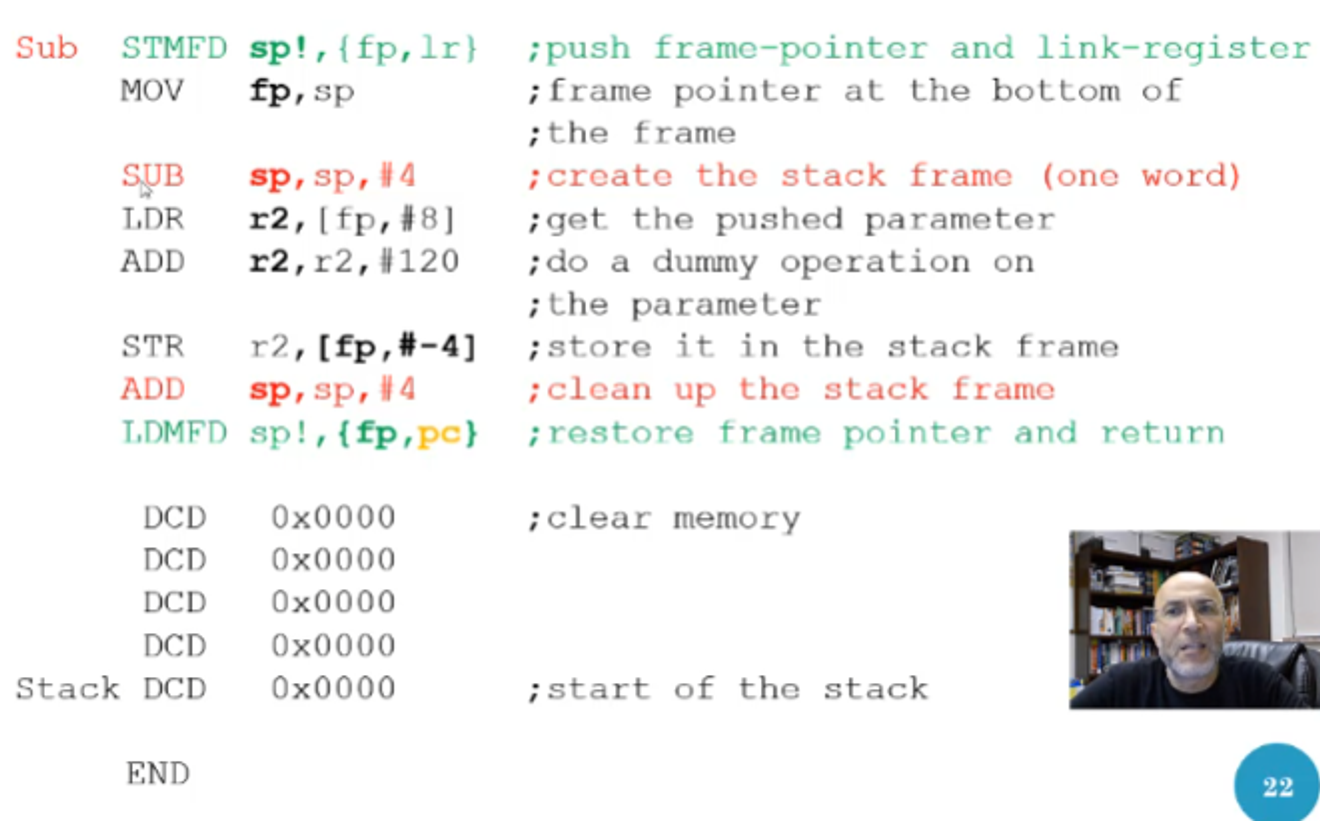
- Note that we modified r2 and did not return it back to what it was originally (this was most likely the point of the subroutine, but just be careful when you do this)
- Setting the fp as #123 doesn’t mean anything, we just want to clear what might already be there
Visually, it looks something like this
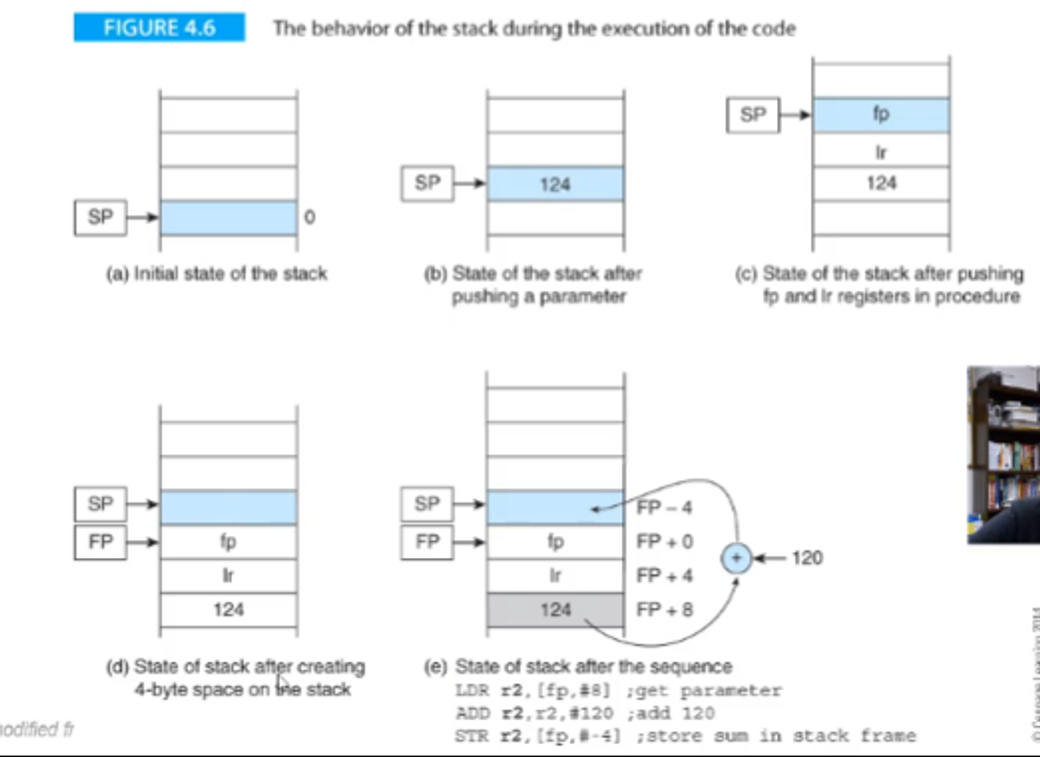
- To collapse and return to the main program, we do the reverse
For the parameter, notice how there’s two steps, one before and one after the subroutine
- Push the parameter(s) on the stack
- Pop the parameter(s) from the stack
More about parameters is below
The provided code examples demonstrate the differences between passing parameters by value and passing parameters by reference in ARM assembly language. Let’s break down each approach in more detail.
Passing by Value
In passing by value, the values of the parameters are copied to the stack, and the subroutine operates on these copies. Here’s the main function setup and the swap function for passing by value:
Main Function
main
SUB sp,sp,#4 ; move the stack pointer up
STR fp,[sp] ; push the frame pointer onto the stack
MOV fp,sp ; the frame pointer points at the base
; int x = 2, y = 3;
SUB sp,sp,#8 ; move sp up 8 bytes for 2 integers
MOV r0,#2 ; x = 2
STR r0,[fp,#-4] ; put x in stack frame
MOV r0,#3 ; y = 3
STR r0,[fp,#-8] ; put y in stack frame
; swap(x, y);
LDR r0,[fp,#-8] ; get y from stack frame
STR r0,[sp,#-4]! ; push y on stack
LDR r0,[fp,#-4] ; get x from stack frame
STR r0,[sp,#-4]! ; push x on stack
BL swap ; call swap, save return address in LR
ADD sp,sp,#8 ; clean the stack from the parameters
MOV sp,fp ; restore the stack pointer
LDR fp,[sp] ; restore old frame pointer from stack
ADD sp,sp,#4 ; move stack pointer down 4 bytes
Loop B Loop ; stop
END
Swap Function
swap
SUB sp,sp,#4 ; Create stack frame: decrement sp
STR fp,[sp] ; push the frame pointer onto the stack
MOV fp,sp ; frame pointer points at the base
; int temp;
SUB sp,sp,#4 ; move sp up 4 bytes for temp
; temp = a;
LDR r0,[fp,#4] ; get parameter a from the stack
STR r0,[fp,#-4] ; copy a to temp onto the stack frame
; a = b;
LDR r0,[fp,#8] ; get parameter b from the stack
STR r0,[fp,#4] ; copy b to a
; b = temp;
LDR r0,[fp,#-4] ; get temp from the stack frame
STR r0,[fp,#8] ; copy temp to b
; Collapse stack frame created for swap
MOV sp,fp ; restore the stack pointer
LDR fp,[sp] ; restore old frame pointer from stack
ADD sp,sp,#4 ; move stack pointer down 4 bytes
MOV pc,lr ; return by loading LR into PC
Passing by Reference
In passing by reference, the addresses of the parameters are passed to the subroutine, which then operates directly on the original variables. Here’s the main function setup and the swap function for passing by reference:
Main Function
main
SUB sp,sp,#4 ; move the stack pointer up
STR fp,[sp] ; push the frame pointer onto the stack
MOV fp,sp ; the frame pointer points at the base
; int x = 2, y = 3;
SUB sp,sp,#8 ; move sp up 8 bytes for 2 integers
MOV r0,#2 ; x = 2
STR r0,[fp,#-4] ; put x in stack frame
MOV r0,#3 ; y = 3
STR r0,[fp,#-8] ; put y in stack frame
; swap(&x, &y);
SUB r0,fp,#8 ; get address of y in stack frame
STR r0,[sp,#-4]! ; push address of y on stack
SUB r0,fp,#4 ; get address of x in stack frame
STR r0,[sp,#-4]! ; push address of x on stack
BL swap ; call swap, save return address in LR
ADD sp,sp,#8 ; clean the stack from the parameters
MOV sp,fp ; restore the stack pointer
LDR fp,[sp] ; restore old frame pointer from stack
ADD sp,sp,#4 ; move stack pointer down 4 bytes
Loop B Loop ; stop
END
Swap Function
swap
SUB sp,sp,#4 ; Create stack frame: decrement sp
STR fp,[sp] ; push the frame pointer onto the stack
MOV fp,sp ; frame pointer points at the base
; int temp;
SUB sp,sp,#4 ; move sp up 4 bytes for temp
; temp = *a;
LDR r1,[fp,#4] ; get address of parameter a
LDR r2,[r1] ; get value of parameter a (i.e., *a)
STR r2,[fp,#-4] ; store *a in temp in stack frame
; *a = *b;
LDR r0,[fp,#8] ; get address of parameter b
LDR r3,[r0] ; get value of parameter b (i.e., *b)
STR r3,[r1] ; store *b in *a
; *b = temp;
LDR r3,[fp,#-4] ; get temp
STR r3,[r0] ; store temp in *b
; Collapse stack frame created for swap
MOV sp,fp ; restore the stack pointer
LDR fp,[sp] ; restore old frame pointer from stack
ADD sp,sp,#4 ; move stack pointer down 4 bytes
MOV pc,lr ; return by loading LR into PC